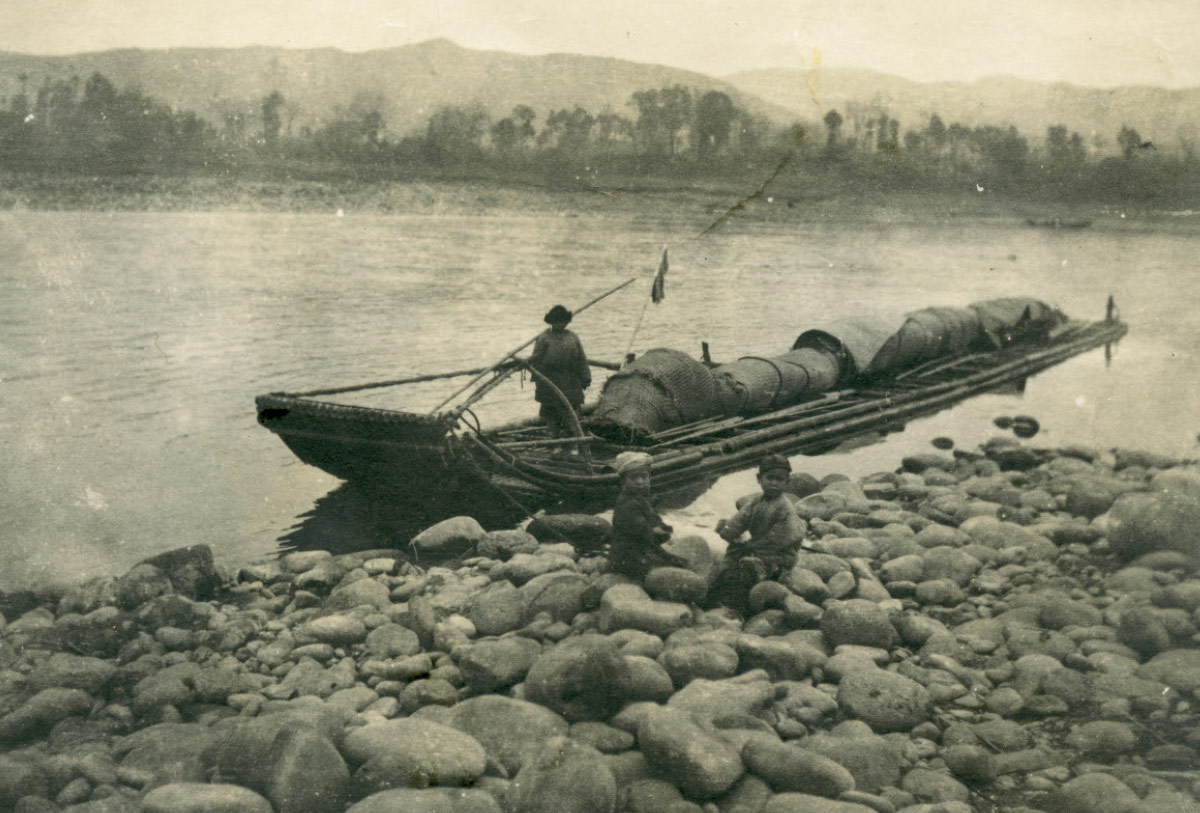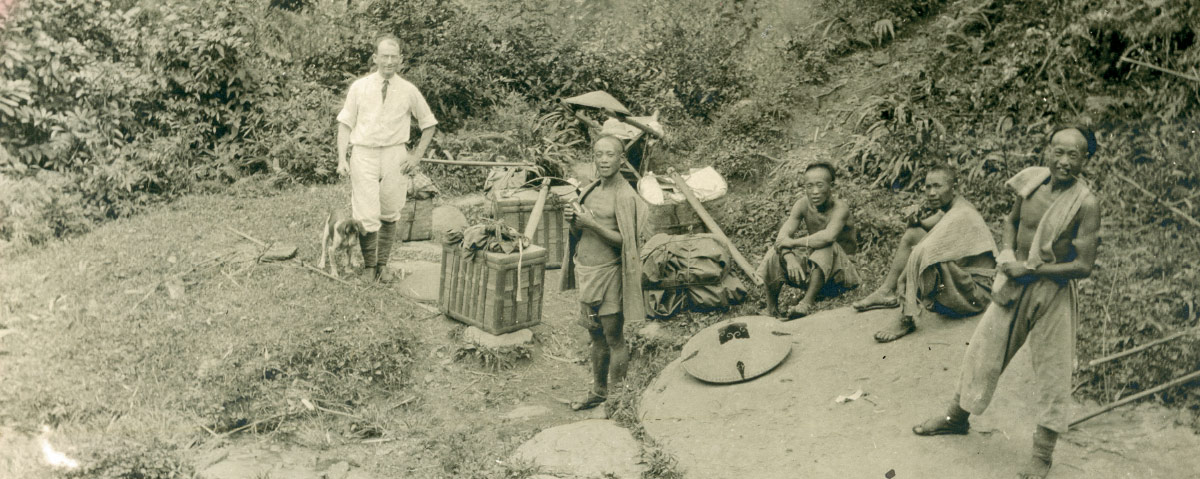China
Edgar Shields is just now coming into focus
n a hot, cloudy September day in 1908, Edgar Shields, Class of 1901, boarded a train in Philadelphia, with his wife and infant son, bound for San Francisco — the first leg of a 138-day journey that would end deep in the mountains of western China.
Even before his graduation from Bucknell seven years earlier, Shields wanted to be a missionary. Two years after earning a medical degree from the University of Pennsylvania, the 31-year-old Lewisburg native was dispatched by the American Baptist Foreign Mission Society to run a hospital in the town of Yachow (known today as Ya’an) in Sichuan province, a location so remote it could only be reached on foot or by sedan chair.
The Susquehanna Valley was literally a world away from the edge of the Tibetan plateau, so Shields arrived ready to chronicle his new life, packing two cameras, including a No. 4 Cartridge Kodak. Over the next seven years, he took more than 800 photographs, including 177 large-format, glass-plate images that offer an extraordinarily detailed look at an isolated part of China in the early 20th century, capturing everything from the quotidian toil of peasants to the grandeur of the landscape.
Shields aimed his boxy camera at a porter, in sandals and bare-chested, carrying a towering bundle of reeds that weighed more than 200 pounds.
He caught the stare of an old Buddhist priest in heavy, silk ceremonial robes.
He recorded trackers harnessed with coarse bamboo ropes as they hauled, step by painful step, a houseboat against a river’s stubborn current.
He also wrote hundreds of pages of letters and diary entries.
Many missionaries took photos, but Joseph Ho, an assistant professor of history at Albion College and expert in the visual practices of American missionaries in China, calls the Shields collection “absolutely amazing,” not only for the breadth of the imagery, but also because it survived for more than a century. “These rich materials could have vanished into the haze of time at any one point in their historical journey,” Ho explains.

For 38 years, boxes of Shields’ photos, diaries, mementoes and correspondence sat forgotten in the Taylorville, Pa., home of his sister, Charlotte, who stashed them away after his 1926 death at age 49. Then, in 1964, two of Shields’ sons discovered the trove while searching the shed for chairs.
“We were sort of poking around and found this box that had some glass plates in them,” recalls the missionary’s 92-year-old son, Ed ’51, a retired electrical engineer in Chagrin Falls, Ohio. “We decided we couldn’t leave these here.”
Several years ago, Ed began transcribing his father’s letters and diaries and digitizing his photos to provide the next generation with a record of his missionary life. The family will donate the materials to the University of Michigan, which holds extensive China-related collections. Ho is providing considerable assistance in this effort.
The process of organizing the collection has brought Shields into sharper focus for younger generations. “When Dad started pulling out the diaries, the voice of my grandfather was just wonderful,” says Tom Shields ’82, an English professor at East Carolina University.
Born in 1877, Edgar Thomson Shields was one of seven children of Katherine and William Shields, who lived in Taylorville, just outside of Lewisburg. On Sundays, in a compromise over the couple’s denominational differences, the three sons joined their mother in attending a nearby Baptist church, while the four daughters and their father went to the Presbyterian service at Buffalo Crossroads. In 1894, the family moved into Lewisburg, but kept the homestead on Col. John Kelly Road.
In the late 19th century, it was common for churches to host visiting missionaries. “The whole family was interested in missionary work,” Ed says.
Another shared family interest was photography. Shields collaborated with his older sister, Ellen, who later would own a photo studio in Lewisburg. When they were teens, Shields would arrange shots with an entry-level Harvard camera or Kodak, while Ellen would oversee developing the images.
In pursuing a missionary path, Shields’ oldest sister, Esther, led the way. After studying nursing, she set off in 1898 for Korea as a Presbyterian missionary; she soon established the country’s first training school for nurses (now affiliated with Yonsei University). A decade later, Shields headed for China with his wife, Frances Elizabeth Davis, a Philadelphia nurse, and their infant, William.
Excerpts from the doctor’s first letters were published on the front page of the Lewisburg Journal on April 30, 1909, under the headline “Dirt and Distress Striking.” After two months of sailing upstream on a houseboat, Shields described the final five miles to Yachow in sedan chairs “… through bamboo groves, along streams, between rice fields.” Another missionary rode a pony with a “string of sleigh bells around his neck that reminded us of our winter rides through the snow at home.” For this newcomer to China, like newcomers to this day, one of his first impressions was the unfathomable density of humanity. For Shields, the crowds were akin to “attending County Fair every day in the week.”
In his diary, the doctor described his new home on the banks of the fast-moving Ya River, situated among rolling hills of wheat and barley that rose into stone peaks. He noted how the farmland included rice paddies, “admirably” tended by peasants using plows hitched to water buffalo, who sunk into the mud with every step. Shields took his camera as he traveled the region, producing images so superior that, after his return home, National Geographic published three of his hand-colored photographs in an article about West China.
During his time in China from 1909 to 1915, Shields witnessed the collapse of the last dynasty and the chaotic transition to a fledgling Republic of China. In 1911, the family was summering at a missionary mountain retreat, where their second child, a daughter, was born. Soon after, the revolution against Qing rule erupted. His diary entries recount the family’s harrowing flight with other missionaries to the safety of Shanghai. Traveling by boat, Shields saw a number of floating bodies, including an infant and a decapitated adult. “If this moody river could tell the secrets hidden in its bosom,” he wrote, “many blood-curdling and awful tales would be forthcoming.”
With his wife and two children ensconced in the international city, Shields left for Nanjing to help at a Red Cross field hospital near the front line of fighting. In his diary, he chronicled the movement of revolutionary forces as well as the minutiae of fundamental societal change. One day, Shields described how two Chinese doctors asked him to cut off their queues, a symbol of revolt against the Manchu rulers of the Qing dynasty who demanded that all men wear long braids.
Shields had every intention of spending his career in China. But on his first home leave in 1915, his wife died, leaving him with two young children and an infant. He never returned. In 1919, he married Ellen Soars of Muncy, Pa., and they had four children.
A mere seven years later, Shields died of a ruptured appendix. His China memorabilia was taken to Charlotte’s shed, where it remained untouched for decades.
“Travel today is so common, and everyone goes everywhere,” says Ellen Shields Wilch ’81, a geneticist who lives in Albion, Mich., and is working with Ho to preserve the photos. “My grandfather was aware of the importance of what these images meant to people back home.”
